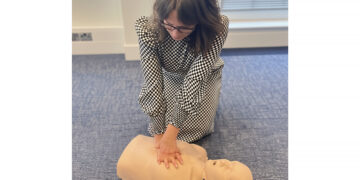With sunshine finally arriving in Berkshire, Dogs Trust is warning dog owners not to over exercise their four-legged friends in the warm weather, as it can cause severe health problems for canine companions.
The dog welfare charity says that too much exercise in early summer temperatures can be dangerous – sometimes even deadly – as it can cause heatstroke in dogs, which can prove fatal.
A recent study showed that 75% of cases of heat-related illnesses in UK dogs were because of exertion, and over two thirds were just from walking only.
Paul Boyden is the veterinary director of Dogs Trust. He said: “After weeks of rain, it’s great to see the sun shining, and many of us will be taking advantage of it to enjoy the great outdoors. And with over a third of households now shared with a dog, we have no doubt that people will be keen to take their dogs along to join in the fun.
“But, while most of us know not to walk or exercise dogs in extreme weather, even these lovely early summer temperatures can cause problems, especially for those dogs with flat-faces or underlying health conditions.
“As owners, we need to know the signs that our dogs are getting too hot and help them take a rest and cool down when they need to. Some dogs aren’t good at self-regulating and may continue to run and play even though they’re hot and tired, which increases their risk of heatstroke.
“If you do spot the signs of heatstroke in your dog, take steps to cool them down and contact your vet immediately.”
The symptoms of heatstroke can include panting heavily, drooling excessively, appearing lethargic, drowsy or uncoordinated, vomiting, diarrhoea, and collapsing.
To find out more about how to keep your dog safe this summer, visit www.dogstrust.org.uk/hotweather
Additional info for web article only
Dogs Trust has shared the following advice to owners if they suspect their dog is experiencing heatstroke:
-
Act immediately to prevent your dog’s condition getting worse.
-
Cool first, transport second.
-
Stop them from playing, walking or whatever activity they’re doing and move the dog to a shaded and cool area.
-
Start cooling them down urgently. For young, conscious, healthy dogs, this means immersing them in cold water, for example in a paddling pool if possible, keeping their head above water. Use any water available, provided it is cooler than your dog. If immersion is not possible, continuous dousing with cold water is an alternative.
-
For older dogs or dogs with health conditions, spray them with room temperature water, avoiding their face, and combine with air movement from a breeze, fan or air conditioning. Place ice, wrapped in a tea towel to prevent ice burns, in their groin and armpits.
-
Always closely monitor cooling and stop if you notice signs of shivering
-
Don’t place a wet towel over them as this can raise their temperature.
-
Call your vet urgently for further advice and transport them there as quickly as is safely possible. Keep the air conditioning on in the car or the windows open.
-
If your dog has collapsed or is struggling to breathe, call your nearest vet immediately.
Dogs Trust also advises that dogs should never be left alone in cars as even just a few minutes in a hot car can prove fatal. As dogs can’t cool down the same way as humans, the heat can quickly become dangerous for them.
If you see a dog in a car in distress, the charity advises that members of the public call 999 immediately.












































